Manga Artist Interview Series (Part III)
The Manga Series > Hentai > Toshio Maeda > Takeshi Oshima > Rui Hashimoto
The Space Shuttle Columbia
disaster earlier this month hit manga
artist Rui Hashimoto a little harder than most. At the
time, she had just finished her latest feature about the life
of Japan's first female astronaut, Chiaki Mukai. Included
were depictions of the Challenger accident in 1986 - a time
when Mukai was still in training as a payload specialist.
A "complete shock" is how Hashimoto described the
irony.
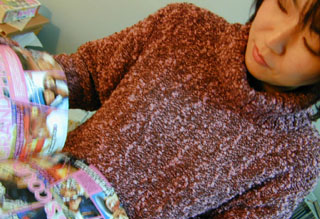 The
book is one in a recent biography series of comics she has
completed for publisher Kodansha.
But getting these assignments - and any manga work at all,
for that matter - is tough these days. Even though manga is
growing
in popularity overseas, domestic publishers are cutting
back as a result of reduced consumer spending - at least on
comics. Further, they are increasingly less interested in
listening to writers' ideas for new works. One of Hashimoto's
former mainstays, the magazine If, recently discontinued
operations altogether.
The
book is one in a recent biography series of comics she has
completed for publisher Kodansha.
But getting these assignments - and any manga work at all,
for that matter - is tough these days. Even though manga is
growing
in popularity overseas, domestic publishers are cutting
back as a result of reduced consumer spending - at least on
comics. Further, they are increasingly less interested in
listening to writers' ideas for new works. One of Hashimoto's
former mainstays, the magazine If, recently discontinued
operations altogether.
Upon entering her home, one can see Hashimoto
is an artist first, with manga being mainly a way to pay the
bills. (A cat-sized grasshopper of twisted metal sits next
to the foyer; shelves of books featuring the works of Paul
Gauguin and Claude Monet fill shelves outside her workroom;
and a large painting of hers featuring a rendition of a multi-colored
piece of seaweed hangs in the stairwell.)
Her manga career is a relatively recent
venture, beginning six years ago after a friend suggested
she put her skills gained from studying toward drawing manga.
She is now working on a feature for the magazine Dejiru
that will profile the complications a mother faces in dealing
with a soon-to-be-married daughter.
Given that as a whole the industry tends
to lean towards content that is rather misogynistic, being
a female is not unique in this field; in fact, Hashimoto often
finds herself sharing ideas with a large group of female artists.
This week the Captain
touches upon the gender issue and much more as he continues
his Manga
Artist Interview Series by sharing excerpts of his conversation
at the home of Hashimoto - his first manga queen in the series.
Profile
Name: Rui Hashimoto
Age: 35
Hometown: Senkawa, Tokyo
Hobbies: Taking care of three cats and one dog
Recent manga reading material: Makoto Isshiki's Piano no
Mori
Former jobs: Italian-to-Japanese translation and waitressing
Interview
Captain Japan: What type of people read your
work?
Rui Hashimoto: Well, women my age - women in
their 30s, read Dejiru and If. My Chiaki Mukai
and Florence Nightingale (Nightingale) books are for
children.
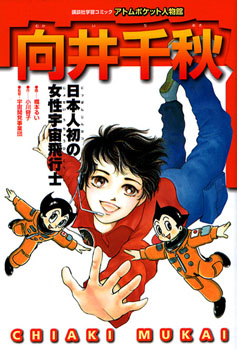 You
know, for the one I am working on now for Dejiru, about
the mother and daughter, I am reading the teen magazine Egg.
It is the best way to get a feel for the kids of today, but
it is really embarrassing (She grabs her copy of Egg
off the table so that I cannot see the tanned and trendy teenage
girls filling its pages - Captain)!
You
know, for the one I am working on now for Dejiru, about
the mother and daughter, I am reading the teen magazine Egg.
It is the best way to get a feel for the kids of today, but
it is really embarrassing (She grabs her copy of Egg
off the table so that I cannot see the tanned and trendy teenage
girls filling its pages - Captain)!
CJ: Do you come up with the ideas for the comics
on your own?
RH: They are my ideas. I must sell them one
by one - it is basically freelance. Sometimes I'll hear that
a publisher is looking for someone who can draw a certain
type of manga, and I'll bring in my samples. That is how I
was able to get the Nightingale job.
I'd like to work on as many different kinds
[of manga] as possible. It is impossible to have all my works
in one magazine because these days magazines are so classified
- some for boys, some for girls, some for women... some for
salarymen interested in hentai
(I mentioned earlier that I had previously interviewed
a few artists whose specialty is perversion - Captain).
If I bring something into a publisher there
is no guarantee [as far as publication]. There are never any
details about when it might be published; it is up to them,
and I have to wait.
CJ: Female artists, like Rumiko Takahasi and Naoko Takahashi,
who draws Sailor Moon, have become famous in Japan.
Did they provide you with any sort of inspiration?
RH: Definitely not Sailor Moon (This
comic is a current children's manga - Captain)! But Yumiko
Igarashi's Candy Candy was a big influence. It was
very famous with little girls. It was similar to Sailor
Moon but for my generation. It was a television cartoon
and manga where a little orphaned girl is adopted into a rich
family; it was sort of like Annie.
CJ: Why did you like it?
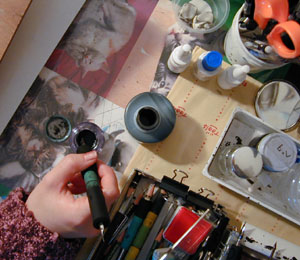 For
the first time I could see that manga is made by regular people,
just like everyday goods like this plate (She picks a ceramic
plate off the table - Captain). It was a first for
me. Daily things are of course made by people; I understood
this, but not when it comes to manga. This is when I started
to learn about art
and drawing.
For
the first time I could see that manga is made by regular people,
just like everyday goods like this plate (She picks a ceramic
plate off the table - Captain). It was a first for
me. Daily things are of course made by people; I understood
this, but not when it comes to manga. This is when I started
to learn about art
and drawing.
But for drawing style, the woodblock print
work of Hokusai Katsushika was an incredible influence. I
really like this type of erotic art (She holds up a book
containing ukiyo-e prints from Katsushika - Captain).
It is really terrific.
CJ: Do you feel discrimination in this business
because you are a woman? Or can this work give women a sense
of freedom?
RH: I don't think about that. It is about your
work, not whether you are a male or not. There is a lot of
energy expended. But there is a limit as to what a person,
male or female, can do. I was working on Nightingale
12 hours a day for 2 months so that I could finish it.
But for freedom, after getting married, many
women work part-time as artists. But, at the same time, if
you are a mother, and drawing while raising a child, sometimes
it is hard to keep your focus.
CJ: If you look at the work of Toshio
Maeda and Takeshi
Oshima, you can see that it is based on perversion and
female exploitation. Of course, it is not just these two artists;
perverted comics compose a large percentage of the manga that
is produced. Do you feel strange working in an industry that
exploits women in such a way?
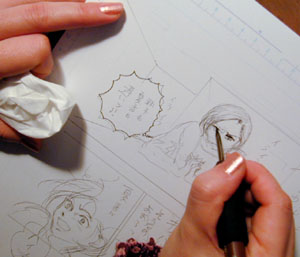 RH:
When I started working as a manga artist my mother was really
concerned about it because she held a bad image about the
business. But now, there is no problem because my manga is
as harmless as Candy Candy - it is at the same level
of appeal or interest. You know, there are so many various
sub-genres of manga that artists can do what they want...and
I can do my own as well.
RH:
When I started working as a manga artist my mother was really
concerned about it because she held a bad image about the
business. But now, there is no problem because my manga is
as harmless as Candy Candy - it is at the same level
of appeal or interest. You know, there are so many various
sub-genres of manga that artists can do what they want...and
I can do my own as well.
CJ: What do you think about Shonen Jump's
popularity overseas?
RH: For my work, it doesn't mean much. But
I'd feel really happy if young kids who read Shonen Jump
now will grow up and start reading manga for adults...but
not hentai [laughs]! It's a great way to transfer Japanese
culture (outside of Japan).
CJ: What is your biggest problem in this business?
RH: There are no jobs [laughs]! And...there
are too many artists (now). The competition is fierce; there
is no balance with readership and production. Some people
have even quit as artists. For me, I am hoping that people
with real drawing skills, or talent, will continue on, producing
great works and making the business stronger.
CJ: So it is the economy's weakened condition
then that is causing the trouble, right?
RH: Yes, it is very difficult. The publishing
companies are hurting. Spirited Away and Musashi Miyamoto's
Vagabond are really the only two popular comics. A
lot of people buy them so their sales are strong.
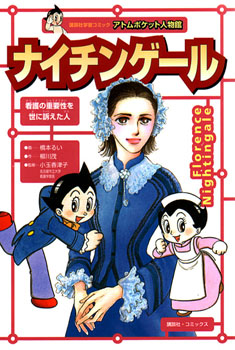 For
me, I am not that famous, and the competition makes it really
tough. I can only look at it one story at a time. But now
I am wondering, though, if I can keep working as a manga artist
or whether I should change to illustration for Web sites. There is so
much demand for drawing characters, images, and mascots for
companies' web pages.
For
me, I am not that famous, and the competition makes it really
tough. I can only look at it one story at a time. But now
I am wondering, though, if I can keep working as a manga artist
or whether I should change to illustration for Web sites. There is so
much demand for drawing characters, images, and mascots for
companies' web pages.
CJ: Do you have fans writing to you?
RH: Well, my editors receive letters sometimes
and they'll send me a copy. Mostly they are from young children.
One time, a mother wrote to say that she and
her daughter read my manga together. The mother was a nurse,
and she taught her daughter about her job through Nightingale.
This made me very happy.
CJ: What are you interested in doing in the
future?
RH: In Japan these days, many young kids are
becoming less and less interested in getting married after
observing the lives of their parents. They see the future
as being bleak; they see their their parents' lives as company
workers as being worthless. I would like to draw manga about
people who still have a little hope in spite of seeing the
reality of life - and I want to give them more hope.
Note: Fumiko Kojima contributed to this
report from the Saitama Bureau. A special thanks goes to Freedom
Lohr of TokyoDV for assisting
in this interview. Images 2 and 5 are courtesy of Kodansha.
The Manga Series > Hentai > Toshio Maeda > Takeshi Oshima > Rui Hashimoto

